With this option the hullform can be converted and exported to a format suitable for use in other software. The most commonly used formats are included in the menu that pops up first, the more exotic varieties are accessible in a sub menu via the last menu option.
How the conversion is done will be discussed below, and
what will be converted depends on the setting per solid in the menu
[Object management], as follows:
- Aimed at the PIAS calculation modules (which apply PIAS' frame model and occasionally the triangulated surface model) the solids and wireframes will be exported which are selected in the PIAS column.
- For NURBS and STL export those solids will be used that are selected in the Export column. It is foreseen that in due time all export is governed by this column, but that is not yet implemented everywhere.
- On export to DXF the user can choose whether only the ‘single selected solid’ will be exported, or all vor Export selected solids. This choice will disappear one of these days.
- With the disused options only the ‘single selected’ solid is exported (what used to be the standard in times past).
- Attention
- It is recommended to read On production fairing before using any of the options from this menu.
Convert this Fairway model to PIAS model
From each object which is selected for PIAS in the menu [Object management] all frames are converted to PIAS' frame model — please refer to Hull form representations for a discussion of the different hull shape models. The converted hullform can be used for all functions and calculations in PIAS. At this conversion, the following mechanisms are applicable:
- In the solid properties menu, three columns are important for this conversion. The column PIAS indicates that an object is converted, the column ‘main hull’ indicates whether the object is part of the main hull form. If that is not the case then the column ‘buoyant’ at ‘yes’ indicates that it is an added form, and at ‘no’ that it is an extra body. All of this in accordance with the categories in Hulldef, see Hullforms and Extra bodies.
- More than one object can be classified as ‘main hullrsquo;. In this case, those are sorted in longitudinal direction, and forwarded to PIAS one after the other. This feature is strictly intended for a hull shape consisting of several independent objects that do not overlap in a longitudinally — such as stern - nave - foreship. If objects nevertheless overlap, Fairway will produce a wrning on that, however, it is up to the user to correct.
- A PIAS frame model must meet a number of conditions, such as those listed in Frames (frame positions and frame shapes). It is the responsibility of the user to observe these rules, Fairway does not check for them.
- To pias' frame model, those lines (=polycurves) are converted which are classified as ‘frames’ in Fairway. So, it is not sufficient for a line de facto to be a frame — because its coordinates share their longitudinal positions — it actually needs explicitly to be from this type.
- Once upon a time all the frames present in a Fairway solid were converted to frames model. Occasionally, that proved to be somewhat inconvenient with frames which did not extend over the entire hull body. Such as an auxiliary ‘frame‘ which only did exist in the bilge area, or a tiny ‘frame’ just existing far above the waterline. For PIAS is based on longitudinal integration of ordinate areas, and as such tiny ‘frames’ have little to no area, they induce a fault in the correct sequence of ordinate areas, and to correspondingly incorrect volumes and stability results. But that's all past; frames are only converted to PIAS only if they extend over the entire hull surface. This ‘entire hull surface’ is interpreted as the surface which is bounded at the edges by a phantom face (see Phantom face for an introduction to this concept). It is good to be aquainted with this background, for if Fairway frames are missing in the PIAS model, then it is advisable to check whether in Fairway these are at the bottom and the top indeed connected to a phantom face (which will by default be the case).
- Parts of frames adjacent to a phantom face are not being converted to PIAS. In order to avoid that lines over CL or at the ship's extremes along the deck are included in PIAS' frame model.
- If longitudinal polycurves, such as waterlines or 3D lines, are present which have the property ‘deck at side’ then the PIAS frames will be cut of at the level of this line or these lines. Please also refer to Deck at side.
- It is advised to verify the resulting frame model thoroughly with Hulldef.
If you use the local cloud (for which reference is made to Local cloud: simultaneous multi-module operation on the same project), the frames do not neccessarily have to be converted to a file, because at any moment the PIAS equivalent of the Fairway hull form is available through the cloud.
If in the solid properties menu it was specified that a solid should also be converted to PIAS' triangulated surface model, then such a file is also created with this menu option.
Offsets to ASCII-file
With this option an ASCII file (*.off) is generated, which contains the coordinates of all lines of the hull form. After selecting this option the number of desired decimals is asked. This file contains all solids which are selected for export, and has the following structure:
- Name of the line.
- Number of points on the line.
- Longitudinal, transverse and vertical coordinates of every point (relative to to the intersection point of the aft perpendicular and the base line) in metres.
- Whether a point is a knuckle or not.
- Whether a point is an intersection or not. When the point is an intersection point, the intersecting line is given as well.
All lines to AutoCAD DXF format in three 2D views
This option produces three *.dxf files. Each file contains one view (front, side and top view). For each view a translation can be given, which allows to fix the layout of the drawing to some extent.
- Warning
- On one hand this option offers the possibility to prepare simple layout operations, on the other hand the possibilities are way too limited to generate an attractive lines plan immediately. The purpose of this option is to help the user to some extent in composing a drawings, because that task is sometimes rather laborious with general CAD systems. This option is not intended to compose a detailed linesplan here, the Fairway ‘linesplan’ facility (see Define and generate lines plan) is much more suitable for that job, especially because such a lines plan can also be exported to a 2D DXF file (as discussed in Output filetype).
All lines in 3D to AutoCAD DXF-polyline format
With this option it is possible to export the 3D network to AutoCAD. After selecting the option you can enter whether you want to convert the waterlines, frames and buttocks to real 3D lines or to 2D lines. Both options result in the same ‘picture’ in AutoCAD. But there is a difference. When you select the option ‘3D lines’, the lines are real 3D lines.
When 2D lines are selected, the model in AutoCAD will for the most part be composed of 2D lines, while the plane in which the lines lie will be rotated in such a manner that a 3D view appears. The difference will become clear when using editing modes in AutoCAD. For example, when using the AutoCAD command [Offset]. This command cannot easily be applied to real 3D lines.
After selecting the line type, you are asked to enter the maximum length of a line segment. In AutoCAD every curve is represented by a so-called ‘polyline’ that is composed of small line segments. The lower the segment length the finer and more accurate the curve representation.
At last you are asked to enter if you want the (non-internal) network points to be exported. When entering [Yes], points will also be generated at curve intersections in the AutoCAD model.
The result is a .dxf file, which contains a ‘polyline’ of every line. Fairway tries its best to generate ‘polylines composed of circle segments’, which allow the curvature of the curve to be approximated. Unfortunately, the DXF format and AutoCAD itself cannot handle 3D polylines containing circle segments (i.e. lines of the Fairway type ‘Spatial polycurves’). Therefore, 3D curves will be composed of straight line segments. As a consequence, ‘polylines composed of circle segments’ can only be exported when the above-mentioned option ‘2D lines’ is used. This shows that the 2D history of AutoCAD is still shining through.
All lines in 3D to AutoCAD DXF-NURBS format
This option generates a DXF-file that contains the Fairway lines in the AutoCAD spline format (DXF group code 100). Actually, this is a 3D NURBS curve, which is the same type as Fairway is using. So this DXF option is not using an approximation like the two mentioned above, but translates the form coefficients of Fairway to DXF, so that with a minimum of information transfer a maximum precision is attained.
All lines as NURBS to IGES
IGES is an abbreviation of Initial Graphics Exchange Specifications, and contains international agreements regarding the file format which is used for the exchange of information between different CAD systems. Fairway uses the IGES type 126; Rational B-spline for this conversion, to a file with extension .igs.
All faces to IGES NURBS patches
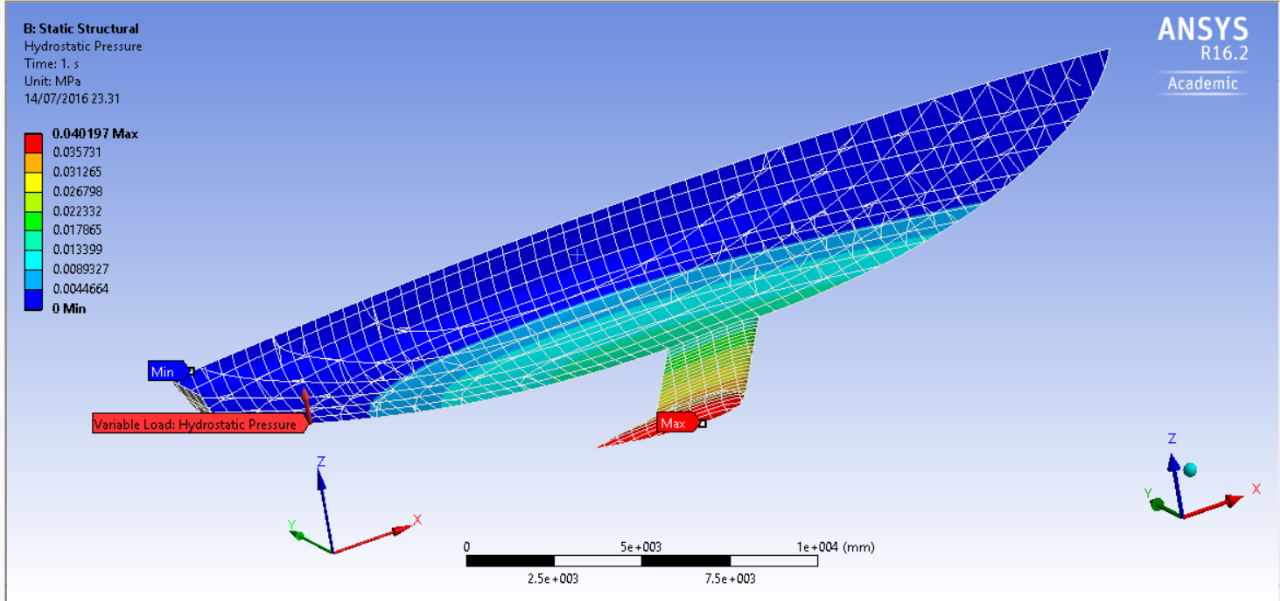
Faces of Fairway, through IGES imported in Ansys.
With this option an IGES file (*.igs) will be created, which contains the facets — so, a surface representation — of the hull shape. In IGES, (curved) facets can only be quadrilateral, in Fairway, they can also be polygonal (eg. five- or six-sided). For that reason, the Fairway facets may be subdivided into multiple, smaller ones. One must realize that the conversion of Fairway to IGES has a finite accuracy, for the following reasons:
- In IGES, many types of representations can be used, but that of Fairway is not among them. This requires conversion which commonly leads to loss of accuracy.
- The most common representation is the NURBS patch. If two such patches are adjacent to each other, and have an unequal number of vertices along their common edge, then there will generally be a gap between the two edges. The gap might be very, very small, but when heavily zoomed in it still can be visible. This has nothing to do with Fairway, this is an intrinsic property of the NURBS.
It can be concluded that IGES and/or NURBS are not capable the represent the Fairway hull shape precisely. However, often there is no other choice, one will have to be practical. As said, IGES accommodates many representations, for the facets Fairway support two of them:
- IGES number 114, the ‘Parametric Spline Surface’.
- IGES number 128, the ‘Rational B-Spline Surface (NURBS)’. This type is the most common, and is recommended.
After choosing the conversion of facets to IGES, the user can choose from two types viz. the most recent, from 2014, and the original, from 1998. It goes without saying that the recent is recommended, the one from 1998 is only present for backward compatibility.
IGES NURBS regions (2018)
This option exports defined shell regions that have the "IGES export patch" option, see [IGES export patch]
IGES faces (2014)
This option creates a parametric or NURBS surface with adjustable accuracy (and corresponding file size). In order of increasing accuracy the options are:
- Without curved surfaces. The IGES facet is only based on the form of the vertices, and therefore, a rough approximation.
- With curved surfaces, with the most simple facets. The facets that are used here are indeed curved, but at the same time of the simplest shape, in case of a NURBS of 16 (4x4) vertices.
- With curved surfaces, with adequate accuracy. Here the number of coefficients or vertices are determined in a way than the mean deviation will be less than 0.1 mm. Please note that this is the average, for individual points the difference between Fairway shape and IGES facet may be more (but that will be compensated by other items where the difference is less).
- With curved surfaces, with high accuracy. Here the number of coefficients or vertices are determined determined such that the mean deviation will be less than 0.01 mm.
Regardless of what accuracy is used, after conversion a window will appear with the converted hull shape. Here, the facets are displayed as they will be written in the IGES file. The user is expected to approve this first, and then click the ‘Authorize and export’ function. Bottom right also a slider is included, which allows the visualization accuracy to be set. This only applies to the drawing accuracy of this window, it has no effect whatsoever on the contents of the IGES file .
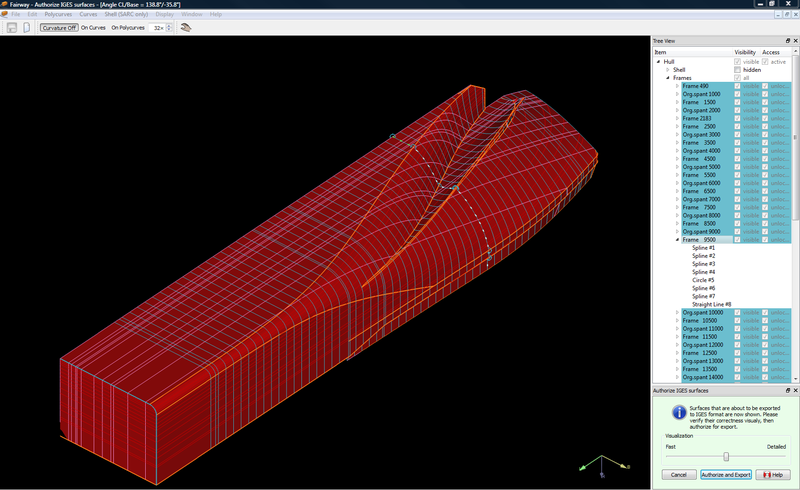
Preview on the IGES file.
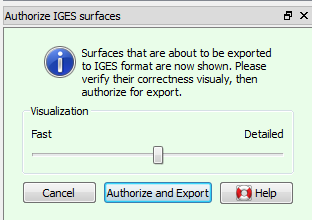
User authorization for export.
IGES faces with raw shape (1998)
This option originates from the late '90s and creates an IGES file which represents the Fairway hull shape approximatively. Here a number of choices have to be made:
- The type of IGES surface, 114 or 128, as discussed above.
- Use the ‘curved surfaces’ capability, at least, when this option is available. In general if use is made of this option a smoother surface will be obtained. By the way, if the ’curved surfaces’ option is not used the system will have to remove internal points. These points will be deleted permanently, so it is to be recommended not to save the hull model on disc anymore.
- Quadruple the number of IGES patches per face. Without quadrupling, in general one IGES surface per face in Fairway is generated. The alternative is four surfaces per face, which may give a better fit between neighbouring IGES surfaces. This option will produce a less ‘raw’ IGES file, however, it is a) a rough remedy, because the number of patches is bluntly quadrupled, and b) not a panacae because quadrupling might still not be sufficient for an accurate result.
- With flattened corners. This option is rather specific; by nature the surfaces will be slightly twisted in the vicinity of their corners, but with this option this twist is artificially flattened. In mathematical parlance this is called zero-twist. The practical relevance is that with hull models which fit or fair badly, the common method may lead to wild fluctuations in the IGES surface. In these cases ‘flattened corners’ could be chosen.
- Only faces which are bordered by visible lines. In this case only faces which are bounded by visible lines at all sides will be converted.
Stereolithography file (.STL) for CFD or 3D printing
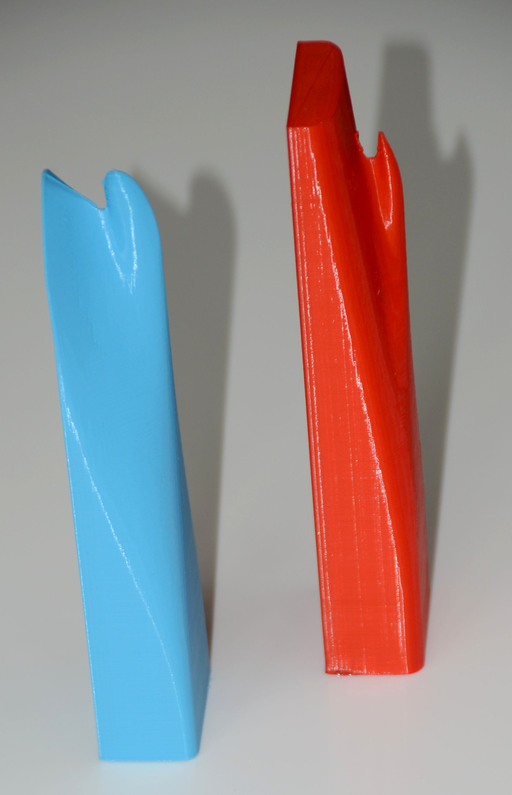
Model designed with Fairway, produced on an Ultimaker 3D printer.
With this option, a .STL file can be produced, which is suitable to produce a scale model of the ship hull with a milling machine or a 3D printer. On the latter has been reported in the SWZ maritime journal, please refer to www.sarc.nl/images/publications/appendix_swz2012.pdf for further reading. Because STL might also be used convert the ship shape to CFD software (for instance to v-Shallo), for that purpose provisions are available in this conversion.
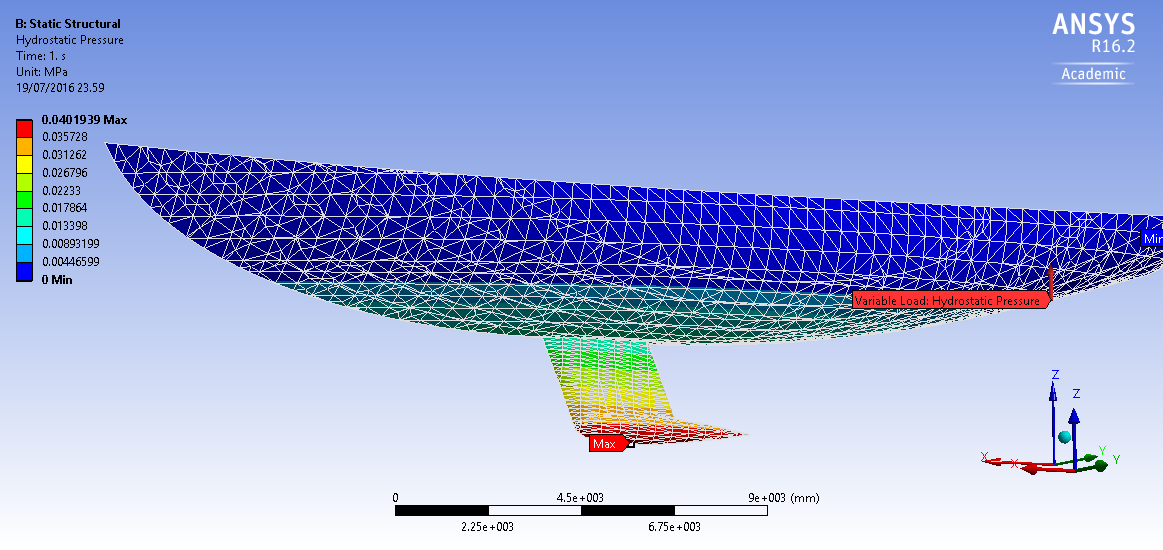
Fairway model, through STL imported in Ansys.
Before generating the STL file, a menu appears where the parameters can be given as discussed below. If this menu is quitted in the regular way then the STL file wil be generated, with [Abort] the conversion will stop without making the STL file.
- Purpose
- The purpose for which the STL file is produced, choice of ‘3D printing of a model’ and ‘CFD (Computational Fluid Dynamics)’. Differences between the two are:
- For 3D printing the STL file must contain a closed solid model, for CFD that is not required. This implies that for printing, the hull will be closed at deck level (if not already the case), for CFD not. Similarly, when printing a demi model the CL plane will be closed, for CFD that is not done.
- For printing the STL file is in millimeters, for CFD in meters.
- For printing a scale can be specified, for CFD not; a CFD model is always actual size.
- For printing a ship can be segmented (subdivided), for CFD that would be useless.
- Format for output file(s)
- Choice between the ASCII or the binary variant of STL. Also the TLOM (Thick Layered Object Manufacturing) is available, however, this is experimental and not generally available.
- Desired maximum triangle size
- Essentially, the STL file format describes a long list of triangles. Here the desired maximum size of each triangle can be entered. It will be obvious that with a smaller triangle size the model will become more accurate, and the number of triangles (and thus the STL file size) will be larger. The triangle size specified here refers to the actual size vessel, and is therefore independant from the model scale. In the subdivsion proces from the surface into small triangles the ‘curved surfaces’ functionality of Fairway is applied, so it only works if that option has been purchased. Concerning the triangle size there are still a few differences between STL for 3D printing and for CFD:
- If a triangle is already fully flat, for 3D printing is not further subdivided, that would be useless. For CFD a different consideration applies, there it will be divided further.
- For CFD it may be useful to define areas of a coarser or finer triangle distributions. This can be assigned to a shell region, please see STL export specifics. There it can also be set that a particular region is fully omitted from conversion to STL.
- Ship side
- If the purpose is CFD, this configures what sides of the ship should be exported.
- Model scale
- Define the reciprocal of the model scale, so X in scale 1/X.
- Subdivide the ship
- Here the choice is offered between:
- ‘Yes, automatically’. In order to take into account the physical limitations of the manufacturing device, ship models are subdivided into producable blocks, see the example in the figure below. This option does that automatically. However, this is still an experimental algorithm, so this feature has not been released for general use.
- ‘No, make demi model’, which will not subdivide the ship, but produce two separate halves, SB ans PS.
- ‘No, make full model’, which will also not subdivide. The STL file will simply contain the entire ship, SB and PS (that is, if the solids have such properties).
- Manufacturing technology and maximum segment dimensions
- These parameters are not discussed further since they are only of interest to ‘automatic subdivision’, but that feature is not generally available.
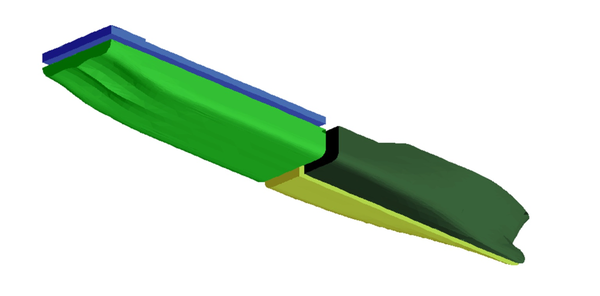
Ship model segmented for 3-axis milling.
- Attention
- De specified triangle size is the maximum size, not the desired size. In other words, faces are being subdivided into smaller triangles, but not merged into larger ones. That would be impossible, because if two triangles are being merged, than usually a quadrangle is created, which does not fit into STL.
- All solids flagged for ‘export’ in the menu [Object management] will be converted to STL. In this respect, one should be aware that the conversion is per individual solid, so the solids will not be merged together in the STL file. If that would be desirable, external STL tools should be used for that purpose.
- Each phantom face (see Phantom face) is omitted from the conversion to STL. Furthermore, it is for the manufacturing of a demi model assumed that the ship is modelled in the conventional Fairway way. I.e. with a phantom face on CL.
- A solid of the type ‘complete’ (so, one which extends over portside and starboard) is not automatically split in two when making a demi model. This must be done manually (with [Centerplane]→[Split] from the solid menu).
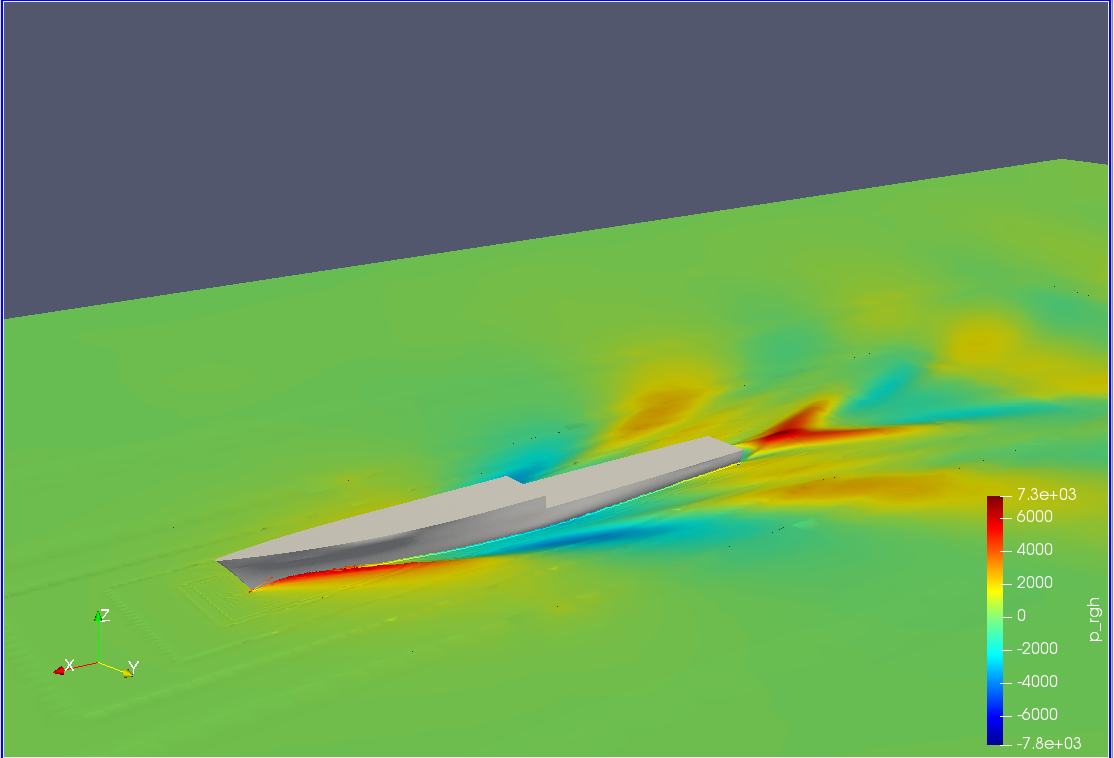
Fairway hullform exported to STL, imported in and computed with OpenFOAM.
Enable hullform to be used as Hull Server shape data base
The background of the Hullserver is that CAD/CAM software (the client) can communicate directly with Fairway, without the use of files. This imnplies that the CAD system and Fairway are running simultaneously on the same computer, with the CAD system repeatedly requesting shape data from the ship model. The Hull Server determines the requested shapes and returns them to the CAD system. This communication is dynamic and is not limited to the set of lines as available in Fairway. For instance, if a client asks for a specific line which does not yet exist in the model, the Hull Server will simply generate that new line and returns its coordinates to the client. Detailled information on the Hull Server is available in a separate document (fwserver.pdf) which is available upon request at SARC. Hullserver clients are available in NUPAS and Mastership engineering software.
This conversion option here in the Fairway export menu option is nothing more but a test which indicates whether the model is sufficiently defined for its use in a production environment. If this is the case, Fairway will mark the model accordingly, so it is fit for application in the Hull Server environment. This check verifies (to some extent) that only proper data are being transferred between both programs. Please note that the model may still contain errors, for example a line may inadvertently be designated as a knuckle (or not), the shape itself may not be satisfactory, etc. This type of errors are caused by (poor) modeling, not by the (interfacing of) software.
Disused export formats
All lines to NUPAS import format
- Attention
- In June 2006 it is agreed with NUPAS' manufacturer NCG that this file interface to NUPAS will be depreciated, because Fairway' hull server mechanism, where Fairway acts as shape database for NUPAS, offers a much more secure and complete conversion. Technically, it is still possible to generate a NUPAS interface file, but it is no longer supported.
If you apply this option, five files (with extension .pnu) are generated, which can be used as 3D lines in early versions of NUPAS. By the way, with option option Enable hullform to be used as Hull Server shape data base a Fairway hull is prepared to be usable for the hull server.
All lines to Eagle format
A file (*.eag) is generated that can be used in Eagle. After selection of this option one is asked to enter the number of coordinates placed at a line in the ASCII-file. Furthermore, the maximum number of points of a line can be entered. When using the <Enter> key the number is not restricted.
Relevant lines to Tribon (Stearbear) format
A file (*.stb) is generated, which can be used in Tribon (which was called Stearbear, in days long past).
Relevant lines to Schiffko format
With this option two files are generated (QS001.DQS and LL0001.DLL) which can be used in Schiffko, are generated. Two methods of conversion are possible: by the network or by the exact frames.
Create finite element model
With this option a ASCII-file, with extension .fem, is generated. This file contains two parts. The first part is a list of all faces with numbers for each point of the faces. These numbers refer to a list of coordinates at the end of the file, where this number corresponds with the coordinates of this point. These data can be used in a finite elements program. It should be noticed that this option exports the faces ‘accidentally’ at hand. Optimization of face dimensions and face location does not occur. In other words, it is not a mesh generator.
Create Dawson-model (MARIN)
With this option the hull form is converted to a *.pnl file, in a format suitable for the potential flow CFD program, as developed by MARIN in the '90s. Before generating a Dawson model, the ‘internal’ network points on the lines have to be removed. The definition of ‘internal’ network points has been given in Basics of Fairway. When removing the ‘internal’ network points, the hullform is not changed. If you want to keep the original model, you have to make a backup. When creating a DAWSON model, you are asked whether all ‘internal’ network points have to be removed automatically. When entering <No>, no Dawson model is created. When entering <Yes>, the following appears: ‘For Dawson the hullform upper boundary must be a (possibly trimmed) waterline. Give the waterline level or the name of that waterline’. Only the hullform under the waterline is important in the Dawson program. Existing waterlines can be entered by giving the height of this line in metres or the name of the line. It is also possible that you want to export the hullform with a certain trim. Then you can define an angled waterline and enter this with its name. An angled waterline can be defined as described in New Planar Polycurve by Intersection.
Frames to Poseidon (DNV•GL)
Poseidon is a scantling-program of DNV•GL. With this option, all defined frames in Fairway are written to a Poseidon readable format. This export option is outdated, because it only concerns the hull form. With Layout both hull form and internal geometry can be converted to Poseidon, see be found in Export to Poseidon (DNV•GL) for more information.
Frames to Castor (ASC)
Castor is a steelweight-estimation program developed by ASC. With this option, all defined frames in Fairway are written to a Castor readable format.
Relevant lines to ShipConstructor
This option, from about 2005, exists and produces files which sould be consumable by ShipConstructor. However, SARC has no knowledge of any test with these files in that program.
On production fairing
In thi schapter the export facilities of Fairway have been discussed. The results can and will be applied in other (CAD and CAE) systems, often also for production purposes. In the latter case the Fairway hull form requires a level of consistency and accuracy which is sufficiently high for production. Fairway offers the user tools to fair for production. However, the actual fairness is dependent on the assessment by the user and the time that has been invested into the fairing process. The use of Fairway as a sole fact is by no means a guarantee that a hull shape is actually fair for production.








